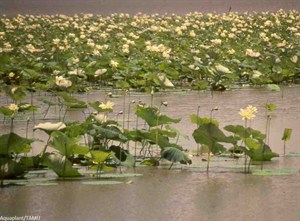

Ecological Importance
American lotus is also known as duck acorn, water nut and yellow lotus. Aesthetically appealing; waterfowl eat the seeds; starchy tubers (roots) can be eaten by humans. The large acorn like seed of lotus is utilized by some ducks and other wildlife. Beavers and muskrats consume the rhizomes. Small to moderate colonies of this plant are considered beneficial to lakes and ponds.
Problems
Large colonies of American lotus may restrict small boat navigation, fishing, and provide habitat for mosquitoes.
Plant Description:
American lotus plants are often confused with water lilies. The leaves of American lotus are simple, circular in shape and up to 2 feet in diameter. Each leaf is attached to rigid stem at the leaf's center.
Leaves are flat if floating or conical if emergent and can stand above the water's surface as high as 3 1/2 feet. Flowers are large (to 10 inches across) yellowish-white to yellow with more than 20 petals. Lotus can form large colonies and spreads by seeds and large fleshy rhizomes.
Hints to Identify
The leaves that protrude above the water often look like inverted umbrellas; the petiole (leaf stalk) is attached to the center of the completely circular leaf; the yellow flower contains many petals; acorn like seeds are housed in a spongy, flat-topped structure.

|
Homeowner Treatment Options
|
| Navigate |
| Renovate Max G |
| Shoreline Defense® Herbicide/Cygnet Plus Combo |
| *Aquatic Biologists recommends implementing preventative management techniques and physical removal prior to, or in conjunction with treatment. |
Common Application Questions
Q. How much should I treat?
A. Spot treat as needed to maintain navigation channels and swimming areas. Remember this plant is very beneficial and should not be treated where it is not a nuisance.
Q. When is the best time to treat?
A. Once water temperatures are around sixty degrees or warmer and/or the plant is actively flowering. American Lotus responds equally well to herbicide treatment when mature.
Q. How often do I need to treat American Lotus?
A. Generally one to two treatments per season is enough.
Q. How long before I see results?
A. It really depends on the product you choose. For most vegetation, control will take approximately 2 weeks however, tissue damage may be evident within 2 to 4 days with liquid formulations. Some products are slower acting with results taking 30 days or more to achieve.
Q. Will the plants come back?
A. If roots are not killed, regrowth may become evident within 4 to 5 weeks.
